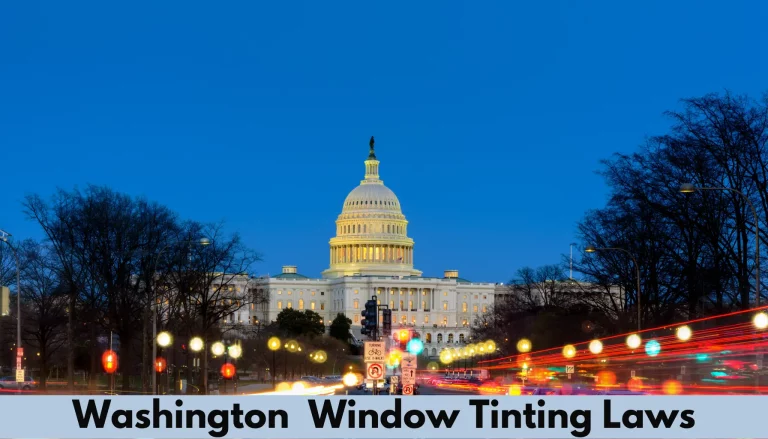Ohio Window Tinting Laws: Stay Legal & Safe
Navigating the rules of the road doesn’t end with stop signs and speed limits. In Ohio, window tinting laws are a key part of staying street-legal. I’m here to guide you through the do’s and don’ts of tinting your car windows in the Buckeye State.
Understanding Ohio’s window tinting regulations is crucial for any driver looking to add that extra touch to their vehicle. Whether you’re aiming for style, privacy, or UV protection, knowing the legal boundaries is a must to avoid fines and keep your car compliant. Let’s dive into what you need to know about Ohio’s window tint laws.
Understanding Ohio’s Window Tinting Laws
When it comes to customizing my ride, I need to know that Ohio law sets specific regulations for window tinting. These rules define the amount of light that must pass through my car’s windows, known as Visible Light Transmission (VLT). In Ohio, the front side windows must allow more than 50% of light in, while the back side windows and rear window can be darker, but they must still allow more than a specified percentage of light to pass through.
It’s also essential to understand that the state prohibits any tint on the windshield, except for a strip at the top. This strip can’t extend more than 6 inches down from the windshield’s top. Moreover, there are restrictions on the type of tint colors I can use; reflective and mirrored tints are a no-go in Ohio. As for tints that can change the color of the glass when viewed from different angles, I’ll need to steer clear of those as well.
| Ohio Window Tint Regulation | VLT Percentage |
|---|---|
| Front Side Windows | Over 50% |
| Back Side Windows and Rear Window | Over specified percentage |
| Windshield Strip | Up to 6 inches |
Regarding the enforcement of these laws, if my car doesn’t comply with Ohio’s tinting standards, I might face fines or be required to remove the tint. That’s why it’s critical to check with a professional or refer to the state’s Department of Motor Vehicles for detailed regulations before getting my windows tinted.
Staying within legal boundaries isn’t just about avoiding tickets; it’s about ensuring the safety of others and myself. Overly dark windows can impede my vision, especially during low-light conditions or at night. Moreover, it’s vital for law enforcement officials to be able to see inside my vehicle during traffic stops for their safety.
Remember that while tints can add to my car’s aesthetic appeal and provide privacy, they shouldn’t compromise my ability to drive safely or align with state law requirements. I always recommend consulting a trusted expert in car window tinting to get the look I want without breaking the law.
The Importance of Complying with Window Tinting Regulations

Adhering to Ohio’s window tinting laws isn’t just about avoiding fines; it’s crucial for both your safety and the safety of others on the road. When I ensure my vehicle meets the state’s tinting regulations, I’m actively enhancing the visibility for all drivers, which can greatly reduce the risk of accidents, especially under low-light conditions.
Visibility is a major concern when it comes to window tints. Windows that are too dark can impair a driver’s ability to see pedestrians, traffic signals, or other vehicles. Ohio’s laws are designed to balance the desire for privacy and UV protection with the necessity for clear sightlines.
Let’s talk about the legal repercussions. If a law enforcement officer stops me and finds my window tint to be beyond the legal limit, I could be facing more than just an inconvenience. I’ll likely be subject to fines and may also receive a ticket requiring me to strip the illegal tint from my windows. This would mean additional expenses and time taken to bring the vehicle back in compliance with the law.
Moreover, insurance companies take these regulations seriously. In an accident, if I’m found to have illegal window tinting, my insurer might challenge my claim, citing non-compliance with state laws as a reason for reduced liability or coverage denial. Getting it right the first time around can save on future headaches and financial stress.
By choosing to stay within Ohio’s tinting guidelines, I’m also maintaining the resale value of my vehicle. Prospective buyers are generally more interested in cars that adhere to legal standards, as they won’t have to deal with the hassle of removing or replacing the tint themselves.
Above all, I like to think about the community benefits of following window tinting laws. It’s a reflection of responsible driving habits and consideration for fellow motorists. Ensuring that my vehicle is compliant demonstrates my commitment to the law and public safety. I’m not just protecting myself; I’m contributing to a safer driving environment for everyone.
| Window | VLT Percentage |
|---|---|
| Windshield | Non-reflective tint on the top 5 inches or AS-1 line |
Factors to Consider Before Tinting Your Car Windows
When I decided to get my car windows tinted, I realized there’s a lot more to consider beyond just the appearance. Trust me, window tinting isn’t just an aesthetic choice; it’s a commitment to your car’s longevity and compliance with local laws.
Visibility is paramount when it comes to driving, and choosing the right tint level is key. Ohio law mandates specific visible light transmission (VLT) percentages for different windows, and these aren’t just guidelines – they’re legal requirements. For instance, the front side windows must allow more than 50% of light in, while the back side and rear windows can be darker. I found it’s best to stick to these rules to avoid any visibility issues during night driving or poor weather conditions.
Next, think about the material quality. High-quality tints are less likely to bubble, peel, or fade over time, which means they’ll look better and perform well for longer periods. They might be pricier, but in the long run, they save money on replacements and maintain the vehicle’s resale value.
The impact on interior protection can’t be overlooked either. UV rays from the sun can cause the upholstery to fade and crack, but a good window tint can block a significant amount of these rays, preserving the interior of my car and keeping it cooler during those hot Ohio summers.
Of course, there’s also the cost factor. Initially, I was tempted to go for the cheapest option, but I soon learned that you often get what you pay for with window tints. Investing in a professional installation with high-grade material is a wise choice, not an extravagance.
Lastly, always check for any recent changes in laws. Ohio, like many states, updates its traffic laws occasionally, and it’s essential to stay informed. I keep an eye out for any modifications in tinting regulations to ensure my car stays street-legal. After all, who needs the hassle of fines or being asked to remove the tint?
Remember, applying window tint is more than just adding a layer to your glass – it’s considering safety, legality, and value in one smart decision.
Legal Limitations on Window Tint Darkness and Reflectiveness
When considering window tinting for your vehicle in Ohio, it’s crucial to understand the legal limitations regarding tint darkness and reflectiveness. Ohio law stipulates specific parameters that must be adhered to if you’re looking to alter your windows with tint.
Understanding Tint Percentages
The state of Ohio measures the darkness of the tint as a percentage known as Visible Light Transmission (VLT). This percentage refers to the amount of visible light that can pass through the window. Ohio’s regulations permit certain VLT levels for different windows on your vehicle:
- Windshield: Tinting must allow more than 70% light in.
- Front side windows: Must allow more than 50% light in.
- Backside windows: Any darkness can be used.
- Rear window: Any darkness can be used, provided that the vehicle has outside rearview mirrors on both sides.
Reflectiveness and Tint Color Restrictions
Beyond the darkness of the tint, Ohio law also controls the reflectiveness, which can affect how much light is reflected away from the vehicle windows. The goal is to limit the mirror-like quality that can result from certain tints, which can be a hazard due to the glare they might create for other drivers.
Here are the permissible reflectivity levels for vehicle windows in Ohio:
- Front side windows: Reflectiveness cannot exceed that of a standard window.
- Backside windows: Reflectiveness cannot exceed that of a standard window.
In addition, there are color restrictions one must keep in mind. In Ohio, colors such as red, yellow, and amber are not allowed for window tinting as they can be confused with emergency vehicles and traffic signals.
Being aware of these limitations and guidelines is crucial to both remain in compliance with Ohio law and ensure that your vehicle is equipped for optimum safety. Remember, it’s not just about improving the aesthetic of your car; it’s also about maintaining legality and contributing to safer roads for everyone. By choosing the right tint levels and reflectiveness, you can enjoy the benefits of a personalized vehicle without running afoul of the law.
Exemptions and Special Permits for Window Tinting in Ohio
While Ohio’s window tinting laws are designed to ensure the safety of drivers, there are specific exemptions that allow for darker tints than what’s normally allowed. Understanding these exemptions can help you determine if you qualify for a permit that grants additional leniency with window tints.
Ohio law recognizes that certain medical conditions necessitate protection from sunlight and UV rays beyond the standard VLT levels. Conditions like lupus, photosensitivity, and melanoma can be reasons for granted exemptions. If you have a medical condition that requires darker window tints, you’ll need to obtain a physician’s signed statement detailing the need for a specific tint level.
Should you qualify for an exemption, you must carry the physician’s statement in your vehicle at all times. Police officers may request to see this documentation during traffic stops or vehicular inspections. Remember, the exemption is specific to the person with the medical condition and not the vehicle. This means that the exemption may not apply if someone without the condition is driving.
Applying for a special permit involves a straightforward process:
- Obtain a signed statement from a licensed physician
- Carry the statement in your vehicle
- Display an exemption sticker on the vehicle, often provided by the state upon approval
For those who don’t qualify for medical exemptions, it’s crucial to stick to Ohio’s tinting regulations to avoid penalties.
The state also makes exceptions for certain types of vehicles. Law enforcement vehicles, for instance, often have different regulations when it comes to window tinting. These exemptions are based on the necessity for privacy and discretion in law enforcement operations.
Keeping abreast of the nuances in Ohio’s window tinting laws ensures you stay within legal boundaries. Whether it’s understanding medical exemptions or recognizing specific vehicle allowances, a clear grasp of these regulations will aid in making informed decisions regarding your car’s window tint.
Consequences of Violating Ohio’s Window Tinting Laws
When you decide to tint your car windows in Ohio, it’s crucial to stay within legal limits. Failing to comply can lead to several unwanted consequences, both immediate and long-term. I’ll take you through what you might face if your window tint doesn’t adhere to Ohio’s strict regulations.
First off, traffic stops are common for vehicles suspected of violating tinting laws. These can lead to on-the-spot inspections. If an officer determines your window tint is too dark or too reflective, you’re likely to receive a non-compliance ticket. The cost of this fine can vary, but it’s an expense that’s easily avoided with proper tinting.
Repeated offenses can have more severe repercussions. Accumulating tickets can lead to heftier fines or even court summons. In extreme cases, non-compliance with tinting laws can result in misdemeanor charges. Additionally, multiple violations may catch your insurance company’s attention, potentially leading to increased premiums or policy complications.
Another point to consider is vehicle inspection. Ohio requires periodic vehicle inspections, and non-compliant tinting can result in a failed inspection. Not only does this mean removing the illegal tint, but it also entails inspection fees and the cost of re-tinting your vehicle legally.
Moreover, consistent violations can result in points on your driving record, impacting your reputation with the DMV. This could also translate into longer wait times for eligibility for certain driving privileges.
It’s also worth noting that non-compliant tinting can hinder resale value. Buyers typically prefer vehicles that meet state requirements to avoid the hassle of removing illegal tint or facing potential fines.
Skirting around Ohio’s window tinting laws can invite a range of problems, from minor inconveniences to serious legal issues. Staying informed and adhering to the permissible VLT levels can save you time, money, and trouble.
Conclusion
Staying on top of Ohio’s window tinting laws is crucial for any car owner in the state. I’ve touched on the importance of compliance for safety, legal standing, and vehicle value. Remember, choosing the right tint isn’t just about style—it’s a commitment to driving safely and maintaining your car’s worth. Keeping abreast of the VLT levels and regulations will save you from unnecessary run-ins with the law and ensure you’re always on the right side of Ohio’s driving regulations. Drive smart, tint wisely, and you’ll enjoy the benefits without the hassle.







